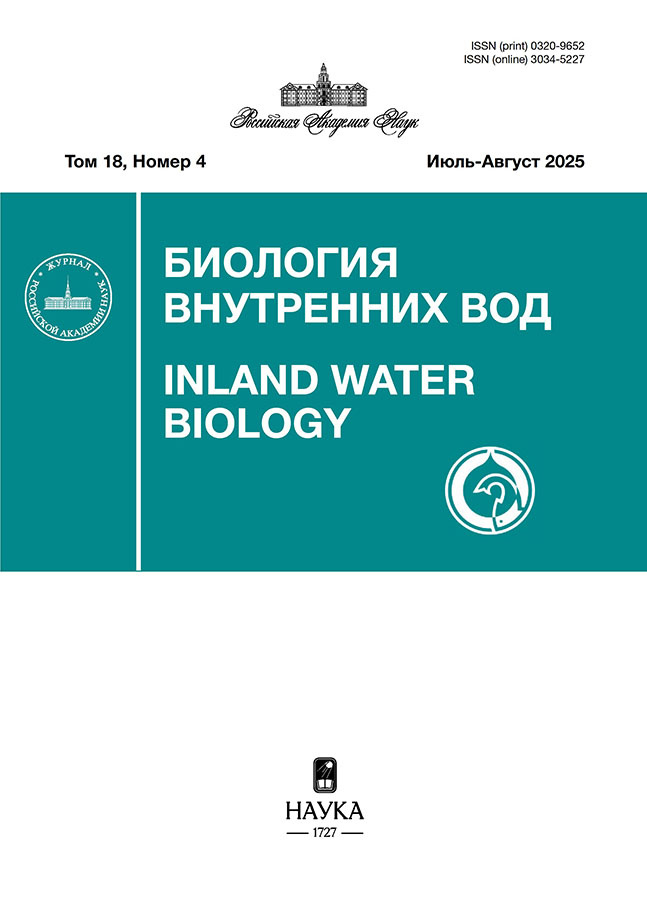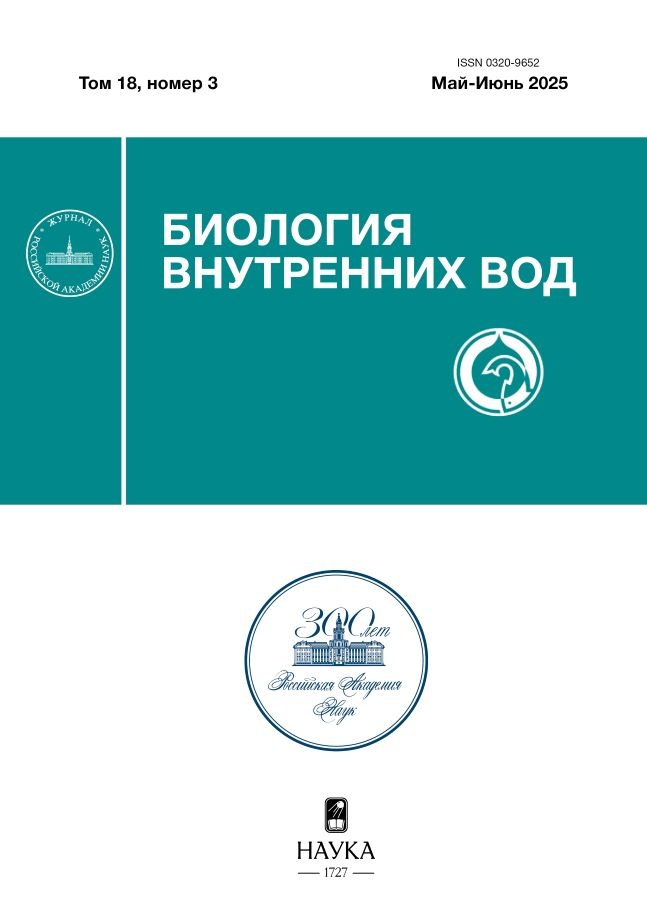Аллелопатические свойства цианобактерий (обзор)
- Авторы: Поляк Ю.М.1, Сухаревич В.И.1
-
Учреждения:
- Санкт-Петербургский научно-исследовательский центр экологической безопасности Российской академии наук
- Выпуск: Том 18, № 3 (2025)
- Страницы: 440–450
- Раздел: ФИТОПЛАНКТОН, ФИТОБЕНТОС, ФИТОПЕРИФИТОН
- URL: https://freezetech.ru/0320-9652/article/view/686983
- DOI: https://doi.org/10.31857/S0320965225030055
- EDN: https://elibrary.ru/IXVANI
- ID: 686983
Цитировать
Полный текст
Аннотация
Настоящий обзор посвящен метаболитам цианобактерий, обладающим аллелопатической активностью. Аллелопатические свойства цианобактерий стали предметом изучения сравнительно недавно, и многие аспекты данной проблемы пока остаются дискуссионными. Химическая структура продуцируемых цианобактериями аллелохимикатов разнообразна (алкалоиды, фенольные соединения, органические кислоты, циклические пептиды, жирные кислоты и др.), а спектр биологического действия чрезвычайно широк и охватывает почти всех водных обитателей. Аллелопатию считают стратегией регуляции сообществ фитопланктона, помогающей поддерживать разнообразие видов в водных экосистемах. Высокую аллелопатическую активность по отношению к водным организмам проявляют цианотоксины, в том числе микроцистины. Помимо влияния аллелохимикатов цианобактерий на представителей фитопланктона, они проявляют противогрибковую, антибактериальную, противовирусную, антиоксидантную, противовоспалительную и противоопухолевую активность, что указывает на потенциал их применения в сельском хозяйстве и фармакологии. В работе рассматривается экологическая роль аллелохимикатов, механизмы их действия и влияние факторов окружающей среды на их образование.
Ключевые слова
Полный текст
Об авторах
Ю. М. Поляк
Санкт-Петербургский научно-исследовательский центр экологической безопасности Российской академии наук
Автор, ответственный за переписку.
Email: yuliapolyak@mail.ru
Россия, Санкт-Петербург
В. И. Сухаревич
Санкт-Петербургский научно-исследовательский центр экологической безопасности Российской академии наук
Email: yuliapolyak@mail.ru
Россия, Санкт-Петербург
Список литературы
- Андреева Н.А., Мельников В.В., Снарская Д.Д. 2020. Роль цианобактерий в морских экосистемах // Биол. моря. T. 46. № 3. С. 16. https://doi.org/10.31857/S013434752003002X
- Гольдин Е.Б. 2013. Биологическая активность микроводорослей и ее значение в межвидовых взаимоотношениях // Экосистемы. № 9(28). C. 49.
- Кондратьев М., Карпова Г., Ларикова Ю. 2014. Взаимосвязи и взаимоотношения в растительных сообществах. М.: РГАУ–МСХА.
- Немцева Н.В., Мамедова Э.И., Немцева Е.К. 2019. Противоопухолевая активность некоторых метаболитов цианобактерий и перспективы их практического использования // Бюлл. Оренбург. науч. центра УрО РАН. № 2. С. 1. https://doi.org/10.24411/2304-9081-2019-12002
- Поляк Ю.М., Поляк М.С. 2022. Роль цианотоксинов в патологии человека и животных (обзор) // Журн. микробиол. эпидемиол. иммунобиол. Т. 99(2). С. 231. https://doi.org/10.36233/0372-9311-230
- Поляк Ю.М., Сухаревич В.И. 2017. Токсигенные цианобактерии: распространение, регуляция синтеза токсинов, способы их деструкции // Вода: химия и экология. № 11–12. С. 125.
- Поляк Ю.М., Сухаревич В.И. 2019. Аллелопатические взаимоотношения растений и микроорганизмов в почвенных экосистемах // Успехи соврем. биол. Т. 2. С. 147. https://doi.org/10.1134/S0042132419020066
- Поляк Ю.М., Сухаревич В.И., Поляк М.С. 2022. Цианобактерии и их метаболиты. СПб.: Нестор-История.
- Поляк Ю.М., Сухаревич В.И. 2023. Проблемы и перспективы использования цианобактерий (обзор) // Биология внутр. вод. № 1. С. 44. https://doi.org/10.31857/S032096522301014X
- Cухаревич В.И., Поляк Ю.М. 2020. Глобальное распространение цианобактерий: причины и последствия (обзор) // Биология внутр. вод. № 6. C. 562. https://doi.org/10.31857/S0320965220060170
- Уиттекер Р. 1980. Сообщества и экосистемы. М.: Мир.
- Babica P., Blaha L., Marsalek B. 2006. Exploring the natural role of microcystins – a review of effects on photoautotrophic organisms // J. Phycol. V. 42. P. 9. https://doi.org/10.1111/j.1529-8817.2006.00176.x
- Bacellar Mendes L.B., Vermelho A.B. 2013. Allelopathy as a potential strategy to improve microalgae cultivation // Biotechnol. Biofuels. V. 6(1). P. 152. https://doi.org/10.1186/1754-6834-6-152
- Becher P.G., Beuchat J., Gademann K., Jüttner F. 2005. Nostocarboline: Isolation and Synthesis of a New Cholinesterase Inhibitor from Nostoc 78-12A // J. Nat. Prod. V. 68. P. 1793. https://doi.org/10.1021/np050312l
- Berry J.P., Gantar M., Perez M.H. et al. 2008. Cyanobacterial toxins as allelochemicals with potential applications as algaecides, herbicides and insecticides // Mar. Drugs. V. 6(2). P. 117. https://doi.org/10.3390/md6020117
- Briand E., Bormans M., Gugger M. et al. 2016. Changes in secondary metabolic profiles of Microcystis aeruginosa strains in response to intraspecific interactions // Environ. Microbiol. V. 18(2). P. 384. https://doi.org/10.1111/1462-2920.12904
- Brilisauer K., Rapp J., Rath P. et al. 2019. Cyanobacterial antimetabolite 7-deoxy-sedoheptulose blocks the shikimate pathway to inhibit the growth of prototrophic organisms // Nat. Commun. V. 10. P. 545. https://doi.org/10.1038/s41467-019-08476-8
- Casanova L.M., Macrae A., de Souza J.E. et al. 2023. The potential of allelochemicals from microalgae for biopesticides // Plants. V. 12. P. 1896. https://doi.org/10.3390/plants12091896
- Chaïb S., Pistevos J.C.A., Bertrand C., Bonnard I. 2021. Allelopathy and allelochemicals from microalgae: An innovative source for bio-herbicidal compounds and biocontrol research // Algal Res. V. 54. P. 102213. https://doi.org/10.1016/j.algal.2021.102213
- Do Amaral S.C., Xavier L.P., Vasconcelos V., Santos A.V. 2023. Cyanobacteria: A promising source of antifungal metabolites // Mar. Drugs. V. 21. P. 359. https://doi.org/10.3390/md21060359
- Etchegaray A., Rabello E., Dieckmann R. et al. 2004. Algicide production by the filamentous cyanobacterium Fischerella sp. CENA 19 // J. Appl. Phycol. V. 16. P. 237. https://doi.org/10.1023/B:JAPH.0000048509.77816.5e
- Gonçalves A.L. 2021. The use of microalgae and cyanobacteria in the improvement of agricultural practices: A review on their biofertilising, biostimulating and biopesticide roles // Appl. Sci. V. 11. P. 871. https://doi.org/10.3390/app11020871
- Granéli E., Hansen P.J. 2006. Allelopathy in harmful algae: A mechanism to compete for resources? // Ecol. Harmful Algae. Berlin: Springer. V. 189. https://doi.org/10.1007/978-3-540-32210-8_15
- Griffiths D.J., Saker M.L. 2003. The Palm Island mystery disease 20 years on: a review of research on the cyanotoxin cylindrospermopsin // Environ. Toxicol. V. 18. P. 78. https://doi.org/10.1002/tox.10103
- Gromov B.V., Vepritskiy A.A., Titova N.N. et al. 1991. Production of the antibiotic cyanobacterin LU-1 by Nostoc linckia CALU 892 (cyanobacterium) // J. Appl. Phycol. V. 3. P. 55. https://doi.org/10.1007/BF00003919
- Gross E.M., Wolk C.P., Jüttner F. 1991. Fisherellin, a new allelochemical from the freshwater cyanobacterium Fisherella muscicola // J. Phycol. V. 27. P. 686. https://doi.org/10.1111/j.0022-3646.1991.00686.x
- Gross E.M. 2003. Allelopathy of aquatic autotrophs // Crit. Rev. Plant Sci. V. 22(3–4). P. 313. https://doi.org/10.1080/713610859
- Hillwig M.L., Zhu Q., Liu X. 2014. Biosynthesis of ambiguine indole alkaloids in cyanobacterium Fischerella ambigua // ACS Chem. Biol. V. 9. P. 372. https://doi.org/10.1021/cb400681n
- Hirata K., Yoshitomi S., Dwi S. et al. 2004. Generation of reactive oxygen species undergoing redox cycle of nostoc in A: a cytotoxic violet pigment produced by freshwater cyanobacterium Nostoc spongiaeforme // J. Biotechnol. V. 110. P. 29. https://doi.org/10.1016/j.jbiotec.2003.12.014
- Hu Z.Q., Liu Y.D., Li D.H. 2004. Physiological and biochemical analyses of Microcystin-RR toxicity to the cyanobacterium Synechococcus elongates // Environ. Toxicol. V. 19. P. 571. https://doi.org/10.1002/tox.20064
- Kaebernick M., Neilan B.A. 2001. Ecological and molecular investigations of cyanotoxin production // FEMS Microbiol. Ecol. V. 35. P. 1. https://doi.org/10.1111/j.1574-6941.2001.tb00782.x
- Keating K.I. 1977. Allelopathic influence on blue-green bloom sequence in a eutrophic lake // Science. V. 196(4292). P. 885. https://doi.org/10.1126/science.196.4292.885
- Konarzewska Z., Śliwińska-Wilczewska S., Felpeto A.B. et al. 2020. Assessment of the allelochemical activity and biochemical profile of different phenotypes of picocyanobacteria from the genus Synechococcus // Mar. Drugs. V. 18(4). P. 179. https://doi.org/10.3390/md18040179
- Inderjit. 1996. Plant phenolics in allelopathy // Bot. Rev. V. 62(2). P. 186.
- Latif S., Chiapusio G., Weston L.A. 2017. Chapter two – Allelopathy and the role of allelochemicals in plant defense // Adv. Bot. Res. V. 82. P. 19. https://doi.org/10.1016/bs.abr.2016.12.001
- Leão P.N., Vasconcelos M.T., Vasconcelos V.M. 2009. Allelopathy in freshwater cyanobacteria // Crit. Rev. Microbiol. V. 35(4). P. 271. https://doi.org/10.3109/10408410902823705
- Leão P.N., Pereira A.R., Liu W.T. et al. 2010 Synergistic allelochemicals from a freshwater cyanobacterium // Proc. Natl. Acad. Sci. USA. V. 107(25). P. 11183. https://doi.org/10.1073/pnas.091434310
- Leflaive J., Ten-Hage L. 2007. Algal and cyanobacterial secondary metabolites in freshwaters: a comparison of allelopathic compounds and toxins // Freshwаter Biol. V. 52. P. 199. https://doi.org/10.1111/j.1365-2427.2006.01689.x
- Legrand C., Rengefors K., Fistarol G.O., Graneli E. 2003. Allelopathy in phytoplankton – biochemical, ecological and evolutionary aspects // Phycologia. V. 42(4). P. 406. https://doi.org/10.2216/i0031-8884-42-4-406.1
- Mason C.P., Edwards K.R., Carlson R.E. et al. 1982. Isolation of chlorine-containing antibiotic from the freshwater cyanobacterium Scytonema hofmanni // Science. V. 215. P. 400. https://doi.org/10.1126/science.6800032
- Molish H. 1937. Der Einfluss einer Pflanze auf die andere: Allelopathie. Jena: Fisher Verlag. (in German).
- Moreira C., Vasconcelos V., Antunes A. 2022. Cyanobacterial blooms: Current knowledge and new perspectives // Earth. V. 3. P. 127. https://doi.org/10.3390/earth3010010
- Nagle D.G., Paul V.J. 1999. Production of secondary metabolites by filamentous tropical marine cyanobacteria: ecological functions of the compounds // J. Phycol. V. 35(6). P. 1412. https://doi.org/10.1046/j.1529-8817.1999.3561412.x
- Omidi A., Esterhuizen-Londt M., Pflugmacher S. 2019. Interspecies interactions between Microcystis aeruginosa PCC 7806 and Desmodesmus subspicatus SAG 86.81 in a co-cultivation system at various growth phases // Environ. Int. V. 131. P. 105052. https://doi.org/10.1016/j.envint.2019.105052
- Pedrol N., González L., Reigosa M. 2006. Allelopathy and abiotic stress // Allelopathy. Dordrecht: Springer. https://doi.org/10.1007/1-4020-4280-9_9
- Pflugmacher S. 2002. Possible allelopathic effects of cyanotoxins, with reference to microcystin-LR, in aquatic ecosystems // Environ. Toxicol. V. 17. P. 407. https://doi.org/10.1002/tox.10071
- Ray S., Bagchi S.N. 2001. Nutrients and pH regulate algicide accumulation in cultures of the cyanobacterium Oscillatoria laetevirens // New Phytol. V. 149. P. 455. https://doi.org/10.1046/j.1469-8137.2001.00061.x
- Reigosa M.J., Sanchez-Moreiras A., Gonzales L. 1999. Ecophysiological approach in allelopathy // Critical Rev. Plant Sci. V. 18. P. 577. https://doi.org/10.1080/07352689991309405
- Rice E.L. 1974. Allelopathy. N.Y., London: Acad. Press.
- Righini H., Francioso O., Martel Quintana A., Roberti R. 2022. Cyanobacteria: a natural source for controlling agricultural plant diseases caused by fungi and oomycetes and improving plant growth // Horticulturae. V. 8. P. 58. https://doi.org/10.3390/horticulturae8010058
- Roy S. 2009. Do phytoplankton communities evolve through a self-regulatory abundance–diversity relationship? // BioSystems. V. 95. P. 160. https://doi.org/10.1016/j.biosystems.2008.10.001
- Rzymski P., Poniedziałek B., Kokociński M. et al. 2014. Interspecific allelopathy in cyanobacteria: Cylindrospermopsin and Cylindrospermopsis raciborskii effect on the growth and metabolism of Microcystis aeruginosa // Harmful Algae. V. 35. P. 1. https://doi.org/10.1016/j.hal.2014.03.002
- Sivonen K., Leikoski N., Fewer D.P., Jokela J. 2010. Cyanobactins – ribosomal cyclic peptides produced by cyanobacteria // Appl. Microbiol. Biotechnol. V. 86. P. 1213. https://doi.org/10.1007/s00253-010-2482-x
- Śliwińska-Wilczewska S., Wiśniewska K.A., Budzałek G., Konarzewska Z. 2021. Phenomenon of allelopathy in cyanobacteria // Ecophysiology and biochemistry of cyanobacteria. Singapore: Springer. https://doi.org/10.1007/978-981-16-4873-1_11
- Srivastava A., Jütmer F., Strasser R.J. 1998. Action of the ailelochemical, fischereilin A on photosystem II // Biochim. Biophys. Acta. V. 1364. P. 326. https://doi.org/10.1016/S0005-2728(98)00014-0
- Sukenik A., Eskhol R., Livne A. et al. 2002. Inhibition of growth and photosynthesis of the dinoflagellate Peridinium gatunense by Microcystis sp. (cyanobacteria): A novel Allelopathic mechanism // Limnol. Oceanogr. V. 47(6). P. 1656. https://doi.org/10.4319/lo.2002.47.6.1656
- Suikkanen S., Fistarol G.O., Granéli E. 2005. Effects of cyanobacterial allelochemicals on a natural plankton community // Mar. Ecol. Prog. Ser. V. 287. P. 1. https://doi.org/10.3354/meps287001
- Teneva I., Velikova V., Belkinova D. et al. 2023. Allelopathic potential of the cyanotoxins microcystin-LR and cylindrospermopsin on green algae // Plants. V. 12. P. 1403. https://doi.org/10.3390/plants12061403
- Tillmann U., Alpermann T., John U., Cembella A. 2008. Allelochemical interactions and short-term effects of the dinoflagellate Alexandrium on selected photoautotrophic and heterotrophic protists // Harmful Algae. V. 7. P. 52. https://doi.org/10.1016/j.hal.2007.05.009
- Valdor R., Aboal M. 2007. Effects of living cyanobacteria, cyanobacterial extracts and pure microcystins on growth and ultrastructure of microalgae and bacteria // Toxicon. V. 49. P. 769. https://doi.org/10.1016/j.toxicon.2006.11.025
- Vardi A., Schatz D., Beeri K. et al. 2002. Dinoflagellate-cyanobacterium communication may determine the composition of phytoplankton assemblage in a mesotrophic lake // Curr. Biol. V. 12. P. 1767. https://doi.org/10.1016/S0960-9822(02)01217-4
- Von Elert E., Jüttner F. 1996. Factors influencing the allelopathic activity of the planktonic cyanobacterium Trichormus doliolum // Phycologia. V. 35. P. 68. https://doi.org/10.2216/i0031-8884-35-6S-68.1
- Yang J., Deng X., Xian Q. et al. 2014. Allelopathic effect of Microcystis aeruginosa on Microcystis wesenbergii: microcystin-LR as a potential allelochemical // Hydrobiologia. V. 727. P. 65. https://doi.org/10.1007/s10750-013-1787-z
- Zak A.A., Kosakowska A. 2016. Cyanobacterial and microalgal bioactive compounds – the role of secondary metabolites in allelopathic interactions // Oceanol. Hydrobiol. Studies. V. 45. P. 131. https://doi.org/10.1515/ohs-2016-0013
- Zhang Y., Duy S.V., Munoz G., Sauvé S. 2022. Phytotoxic effects of microcystins, anatoxin-a and cylindrospermopsin to aquatic plants: a meta-analysis // Sci. Total Environ. V. 810. P. 152104. https://doi.org/10.1016/j.scitotenv.2021.152104
Дополнительные файлы













